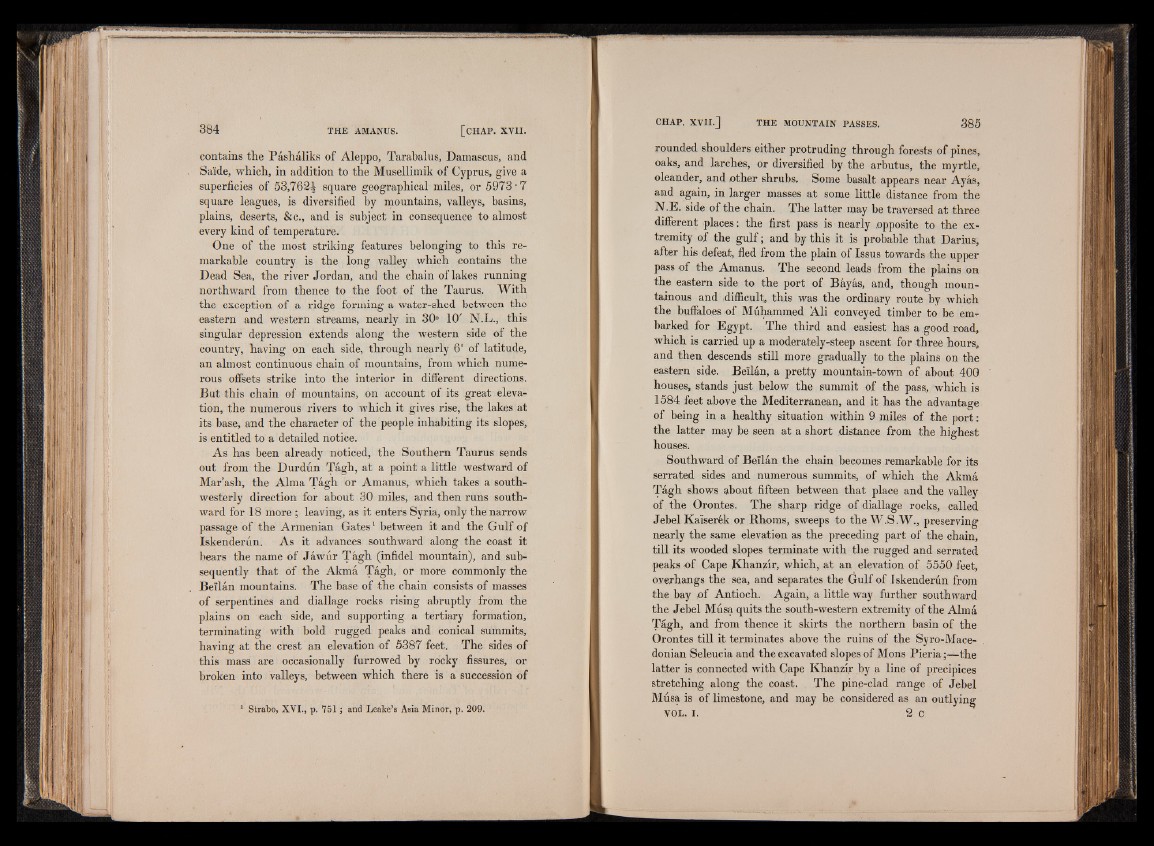
contains the Pashaliks of Aleppo, Tarabalus, Damascus, and
Sa'ide, which, in addition to the Musellimik of Cyprus, give a
superficies of 53,762^ square geographical miles, or 5973 • 7
square leagues, is diversified by mountains, valleys, basins,
plains, deserts, &c., and is subject in consequence to almost
every kind of temperature.
One of the most striking features belonging to this remarkable
country is the long valley which contains the
Dead Sea, the river Jordan, and the chain of lakes running
northward from thence to the foot of the Taurus. With
the exception of a ridge forming a water-shed between the
eastern and western streams, nearly in 30° 10' N.L., this
singular depression extends along the western side of the
country, having on each side, through nearly 6° of latitude,
an almost continuous chain of mountains, from which numerous
offsets strike into the interior in different directions.
But this chain of mountains, on account of its great elevation,
the numerous rivers to which it gives rise, the lakes at
its base, and the character of the people inhabiting its slopes,
is entitled to a detailed notice.
As has been already noticed, the Southern Taurus sends
out from the Durdun Tagh, at a point a little westward of
Mar’ash, the Alma Tagh or Amanus, which takes a southwesterly
direction for about 30 miles, and then runs southward
for 18 more ; leaving, as it enters Syria, only the narrow
passage of the Armenian Gates1 between it and the Gulf of
Iskenderun. As it advances southward along the coast it
bears the name of Jawur Tagh (infidel mountain), and subsequently
that of the Akma Tagh, or more commonly the
Beilan mountains. The base of the chain consists of masses
of serpentines and diallage rocks rising abruptly from the
plains on each side, and supporting a tertiary formation,
terminating with bold rugged peaks and conical summits,
having at the crest an elevation of 5387 feet. The sides of
this mass are occasionally furrowed by rocky fissures, or
broken into valleys, between which there is a succession of
1 Strabo, XVI., p. 751 ; and Leake’s Asia Minor, p. 209.
rounded shoulders either protruding through forests of pines,
oaks, and larches, or diversified by the arbutus, the myrtle,
oleander, and other shrubs. Some basalt appears near Ayas,
and again, in larger masses at some little distance from the
N.E. side of the chain. The latter may be traversed at three
different places: the first pass is nearly opposite to the extremity
of the gulf; and by this it is probable that Darius,
after his defeat, fled from the plain of Issus towards the upper
pass of the Amanus. The second leads from the plains on
the eastern side to the port of Bayas, and, though mountainous
and difficult, this was the ordinary route by which
the buffaloes of Muhammed Ali conveyed timber to be embarked
for Egypt. The third and easiest has a good road,
which is carried up a moderately-steep ascent for three hours,
and then descends still more gradually to the plains on the
eastern side. Beilan, a pretty mountain-town of about 400
houses, stands just below the summit of the pass, which is
1584 feet above the Mediterranean, and it has the advantage
of being in a healthy situation within 9 miles of the port:
the latter may be seen at a short distance from the highest
houses.
Southward of Beilan the chain becomes remarkable for its
serrated sides and numerous summits, of which the Akma
Tagh shows about fifteen between that place and the valley
of the Orontes. The sharp ridge of diallage rocks, called
Jebel Kaiserfek or Rhoms, sweeps to the W.S.W., preserving
nearly the same elevation as the preceding part of the chain,
till its wooded slopes terminate with the rugged and serrated
peaks o f Cape Khanzir, which, at an elevation of 5550 feet,
overhangs the sea, and separates the Gulf of iskenderun from
the bay of Antioch. Again, a little way further southward
the Jebel Musa quits the south-western extremity of the Alma
Tagh, and from thence it skirts the northern basin of the
Orontes till it terminates above the ruins of the Syro-Mace-
donian Seleucia and the excavated slopes of Mons Pieria;—the
latter is connected with Cape Khanzlr by a line of precipices
stretching along the coast. The pine-clad range of Jebel
Musa is of limestone, and may be considered as an outlying
v o l . i 2 c